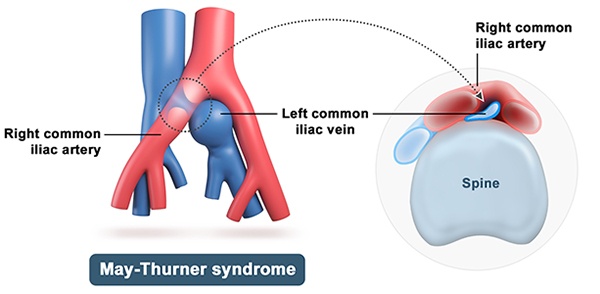Along with treating varicose veins and superficial venous insufficiency, the fellowship trained interventional radiologists at AMIR are experts in recognizing and treating problems in the deep veins. A few of the AMIR areas of expertise include:
May-Thurner’s syndrome and other Pelvic Vein Blockages
Narrowing or blockage of the iliac veins in the pelvis can lead to leg swelling, blood clots, and varicose veins. When these symptoms occur in the left leg and are caused by compression of the left iliac vein by the right iliac artery (See Figure), it is called May-Thurner’s Syndrome.

Blockages of the iliac veins and inferior vena cava can also be caused by tumors, scarring from radiation or retroperitoneal fibrosis, and IVC Filters. These narrowings can also be treated with balloon angioplasty and stents similar to May-Thurners’s syndrome.
It is extremely important to recognize these issues before treating any varicose veins. Blocking the superficial venous system in a patient with deep venous disease can be catastrophic. The fellowship trained, board certified interventional radiologists at AMIR are experts at evaluating and treating the underlying cause of your venous disease.
Deep Venous Thrombosis and Pulmonary Embolism
Deep venous thrombosis (DVT) occurs when blood clots form inside the deep veins, most often in the legs. If the clots are severe enough, they can lead to extreme pain, swelling, and loss of circulation. If these clots break off and float to the lungs, it is called pulmonary embolism (PE). Interventional radiologists can treat DVT and PE by using machines and medicines that break the clot (thrombolysis) or remove the clot (thrombectomy).
IVC Filter Placement and Retrieval
Inferior vena cava (IVC) filters are metal “traps” placed in the largest vein in the body to prevent blood clots from breaking away from the legs and going into the pulmonary arteries. Although these can be life-saving in the short term, there are many long term negative side effects of IVC filters. The metal legs of the filter often stick through the walls of the IVC and can cause injury of surrounding intestines, aorta, or vertebrae. If left in long enough, IVC filters can actually cause clotting and blockage of the IVC and lead to swelling and DVT in both legs. In addition, filters can break and parts can move into your lungs or heart. IVC filters should be removed when no longer needed and the experts at AMIR have multiple advanced tools to remove your filter whether it has been in for 2 months or 20 years.
SVC Syndrome
The superior vena cava (SVC) is a large vein that drains the upper half of the body including the head, neck, and arms to the heart. This can get narrowed or blocked off by cancer or scarring from hemodialysis and lead to life threatening swelling of the face, neck, and arms leading to trouble breathing. These blockages can be treated with balloon angioplasty and stents by the expert interventional radiologists at AMIR.
Paget-Schroetter Syndrome
In Paget-Shroetter Syndrome, blood clot in an arm vein is caused by narrowing at the chest wall. At AMIR, we can use the techniques described above the to clear out the clot and improve blood flow in the arm prior to referring patients for surgery to open up the narrowing.
Nutcracker Syndrome
In Nutcracker Syndrome, the left renal vein is narrowed between the aorta and another artery. This leads to high pressures in the veins of the left kidney and can lead to blood in the urine and left flank pain.
Budd-Chiari Syndrome
In Budd-Chiari Syndrome, the IVC or hepatic veins become blocked off. These blockages can be treated with balloon angioplasty, stenting, or TIPS (transjugular intrahepatic portosystemic shunt) bypass.
The experts at Advanced Midwest Interventional Radiology use minimally invasive procedures to treat a wide range of conditions including deep venous disease. We strongly believe in patient-centered care and use state-of-the-art technology. For all appointments and inquiries, please call or Click here to request an appointment online.





